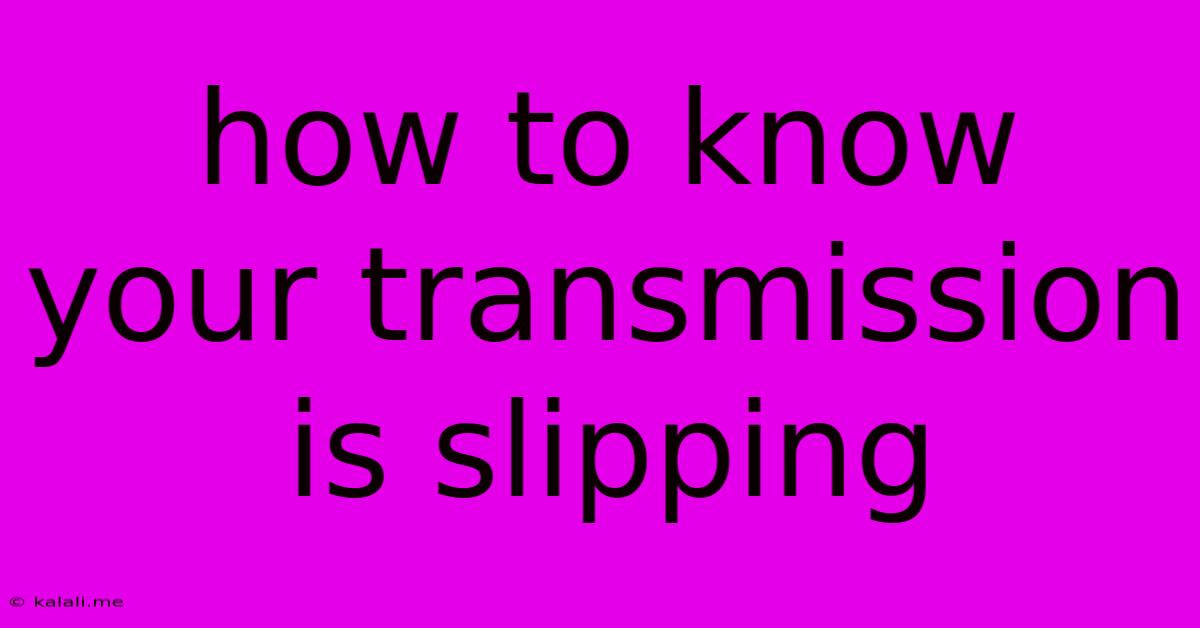How To Know Your Transmission Is Slipping
Kalali
Jun 07, 2025 · 3 min read

Table of Contents
How to Know Your Transmission is Slipping: A Comprehensive Guide
Is your car hesitating, struggling to accelerate, or making strange noises? You might be experiencing transmission slippage. This is a serious issue that requires immediate attention to prevent further damage and costly repairs. This comprehensive guide will help you identify the signs of a slipping transmission and understand what steps you should take.
What is Transmission Slippage?
Transmission slippage occurs when your car's transmission fails to engage properly. Instead of smoothly transferring power from the engine to the wheels, there's a loss of power, resulting in a noticeable delay or hesitation in acceleration. This happens because the transmission's clutch plates are worn, damaged, or low on transmission fluid.
Key Signs Your Transmission is Slipping:
Several symptoms indicate a potential transmission problem. Let's examine some of the most common ones:
1. Delayed Acceleration or Hesitation:
This is often the first sign. When you press the accelerator, you experience a delay before the car responds, or the acceleration is sluggish and inconsistent. This is particularly noticeable when accelerating from a stop or climbing hills. This is often coupled with a revving engine that doesn't translate to increased speed.
2. Loud Noises or Whining Sounds:
A slipping transmission often produces unusual noises. These can include whining sounds, grinding noises, or a humming noise, particularly when accelerating or shifting gears. This indicates friction within the transmission and warrants immediate attention. Pay close attention to changes in sound, especially if they increase in intensity with acceleration.
3. Rough Shifting or Gear Hunting:
Your car might struggle to shift smoothly between gears. You might feel jerking, bumping, or difficulty engaging gears. The transmission may also "hunt" for the right gear, repeatedly shifting up and down without finding the optimal gear ratio.
4. Burning Smell:
A burning smell emanating from the transmission area is a serious warning sign. This indicates friction and overheating within the transmission, often caused by low transmission fluid or failing components. This requires immediate action.
5. Transmission Fluid Leak:
Check for leaks under your vehicle. Transmission fluid is typically bright red or brownish-red. A leak indicates a significant problem that needs immediate repair. Low fluid levels can also cause slippage.
What to Do If You Suspect Transmission Slippage:
- Don't ignore the problem: Continuing to drive with a slipping transmission can cause significant damage and increase repair costs dramatically.
- Check your transmission fluid: Check the fluid level and condition. Low fluid, dark fluid, or fluid with a burnt smell all indicate issues.
- Consult a mechanic: A professional mechanic can diagnose the exact problem and provide an accurate repair estimate. They can perform a thorough inspection and identify the source of the slippage.
Preventing Transmission Slippage:
- Regular maintenance: Regular transmission fluid changes, following the manufacturer's recommendations, are crucial for extending the life of your transmission.
- Avoid harsh driving: Aggressive acceleration and braking put extra stress on the transmission.
- Pay attention to warning signs: Early detection is key to preventing major repairs.
Ignoring the signs of a slipping transmission can lead to costly repairs or even a complete transmission failure. By understanding the symptoms and taking prompt action, you can protect your vehicle and your wallet. Remember, professional diagnosis and repair are always recommended when dealing with transmission issues.
Latest Posts
Latest Posts
-
How Much Water Does A Dishwasher Use Per Cycle
Jun 07, 2025
-
How To Make A Spawning Pad For Wither Skeletons
Jun 07, 2025
-
How To Get Unstuck From Snow
Jun 07, 2025
-
How To Remove Washing Machine Drum
Jun 07, 2025
-
Thunddeerbolt For 3 Monitor Macbook Pro A1708
Jun 07, 2025
Related Post
Thank you for visiting our website which covers about How To Know Your Transmission Is Slipping . We hope the information provided has been useful to you. Feel free to contact us if you have any questions or need further assistance. See you next time and don't miss to bookmark.